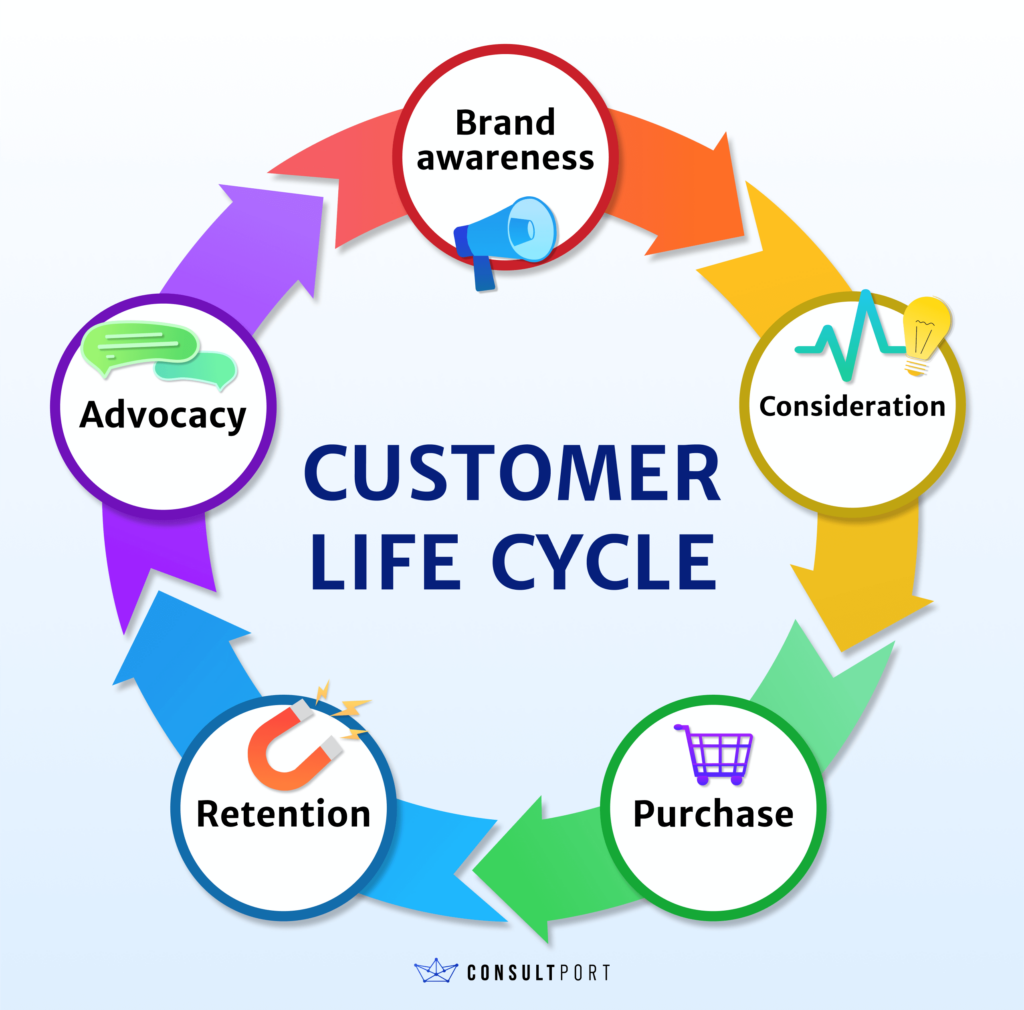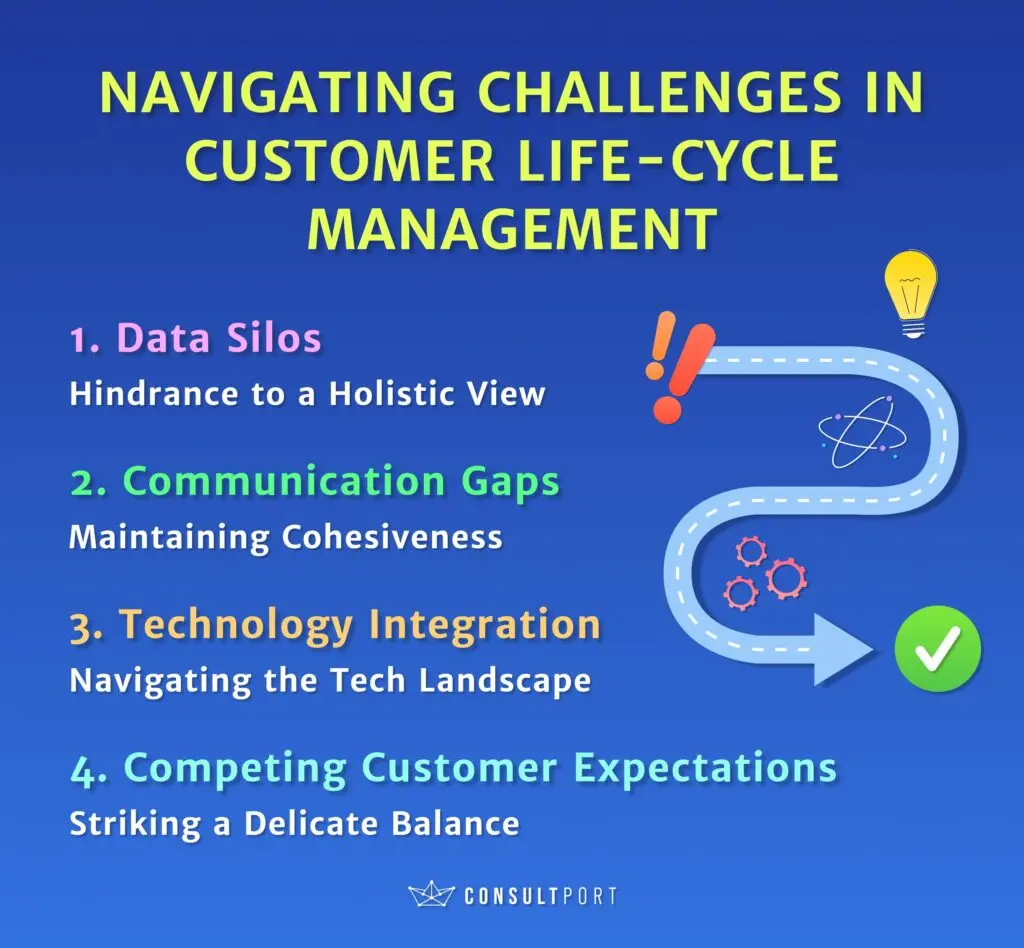Know Your Audience: A Guide to Customer Life Cycle Management


Share this article

In the fast-paced world of contemporary business, understanding Customer Life-Cycle Management (CLM) isn't just an option – it's a strategic necessity. This article aims to break down CLM, highlighting its stages, emphasizing the importance of understanding customer needs, addressing common challenges businesses face, and presenting practical best practices.
The goal is to equip businesses with actionable insights, enabling them to navigate each phase of the customer life cycle effectively. The focus is on building enduring relationships and driving sustainable growth in today's ever-changing market.
The goal is to equip businesses with actionable insights, enabling them to navigate each phase of the customer life cycle effectively. The focus is on building enduring relationships and driving sustainable growth in today's ever-changing market.
The Stages of the Customer Life Cycle

Awareness - Capturing Attention:
The initial stage of Customer Life-Cycle Management involves creating brand awareness. Through strategic marketing efforts, engaging content, and a compelling brand story, businesses aim to capture the attention of potential customers in a saturated market.Utilizing social media, content marketing, and targeted advertising can be instrumental in establishing awareness. As awareness is established, the transition to the consideration phase becomes pivotal.
Consideration - Crafting Value Propositions:
In the consideration phase, customers actively evaluate offerings. Therefore, transparent communication and a clear demonstration of unique value become paramount.Businesses need to showcase how their products or services fulfill customer needs better than competitors by providing detailed product information, customer testimonials, and comparative analysis aids in the decision-making process. Successfully navigating consideration paves the way for the critical purchase stage.
Purchase - Ensuring Seamless Transactions:
The purchase stage is the culmination of the customer's decision-making process. Here, businesses must provide a seamless experience, from easy transactions to transparent pricing, to ensure customer satisfaction and encourage repeat business.Efficient e-commerce platforms, secure payment gateways, and personalized shopping experiences contribute to the success of this stage.
Post-Purchase Engagement - Nurturing Long-Term Relationships:
Post-purchase engagement involves customer support, feedback collection, and efforts to ensure customers feel valued. This phase sets the foundation for long-term relationships and lays the groundwork for repeat business. Personalized follow-up emails, loyalty programs, and proactive customer service initiatives are pivotal in this stage.Loyalty and Advocacy - Turning Customers into Ambassadors:
The pinnacle of the customer life-cycle is achieving loyalty and advocacy. Satisfied customers not only continue their relationship with the brand but become advocates, promoting the business through positive reviews and referrals. Creating loyalty programs, seeking customer feedback for continuous improvement, and acknowledging customer advocacy contribute to solidifying brand loyalty.KEY TAKEAWAYS
- Understanding Customer Needs is Fundamental: Effective Customer Life-Cycle Management (CLM) hinges on a deep understanding of customer needs. Tailoring products and services to meet these needs enhances satisfaction and fosters loyalty.
- Personalization Drives Positive Relationships: A personalized approach, informed by data and customer feedback, creates a customer-centric environment. By customizing interactions and offerings based on individual preferences, businesses enhance overall customer satisfaction, laying the groundwork for positive and enduring relationships.
- Proactive Engagement Builds Loyalty: It is crucial to actively engage with customers by anticipating their needs, addressing concerns, and providing relevant information. This approach fosters a sense of loyalty as customers appreciate the attentiveness to their requirements, contributing to long-term relationships.
- Data Utilization for Continuous Improvement: Businesses that actively collect and analyze customer data gain valuable insights that become a foundation for refining products, services, and overall customer experiences, ensuring a dynamic and responsive approach to evolving customer needs.
The Crucial Role of Understanding Customer Needs
Understanding customer needs is the linchpin of effective CLM. Businesses that tailor their products and services to meet these needs not only enhance customer satisfaction but also foster loyalty.
A personalized approach, informed by data and customer feedback, creates a customer-centric environment, driving repeat business and positive word-of-mouth.

Implementing Customer Relationship Management (CRM) systems that integrate data from various touchpoints helps in breaking down these silos.
Communication Gaps - Maintaining Cohesiveness: Inconsistent communication can lead to misunderstandings and dissatisfaction. Ensuring a cohesive message throughout the life cycle is essential to prevent customers from feeling disjointed or undervalued.
Implementing an omnichannel communication strategy, where messaging is consistent across all platforms, helps maintain cohesiveness. Integrating technology is often cited as a solution, but it comes with its own set of challenges.
Technology Integration - Navigating the Tech Landscape: Implementing and integrating Customer Life-Cycle Management technologies can be complex. Businesses often face challenges in adopting and optimizing tools to enhance the customer experience seamlessly. Utilizing advanced analytics, Artificial Intelligence (AI), and automation can streamline processes and provide valuable insights into customer behavior.
Competing Customer Expectations - Striking a Delicate Balance: Balancing competing customer expectations poses another challenge. Striking a balance between personalized experiences and a scalable approach requires strategic planning and continuous adaptation. Conducting regular customer surveys, analyzing feedback, and staying agile in response to changing expectations contribute to achieving this delicate balance.

Proactive Issue Resolution: Zappos' Customer-Centric Approach: Proactive issue resolution emerges as a crucial best practice, as demonstrated by Zappos. Renowned for exceptional customer service, Zappos goes beyond reactive problem-solving. Proactively addressing potential issues and exceeding customer expectations contributes to their success. This not only resolves problems swiftly but also enhances customer trust and satisfaction.
Customer Feedback Integration - Salesforce's Real-time Response: Salesforce's customer feedback integration showcases the power of actively listening to customers. Real-time feedback mechanisms contribute to continuous improvement, aligning products and services with customer expectations. Utilizing customer feedback for real-time adjustments demonstrates a commitment to customer satisfaction.
A personalized approach, informed by data and customer feedback, creates a customer-centric environment, driving repeat business and positive word-of-mouth.
- Tailoring Products and Services to Customer Preferences: Understanding customer needs goes beyond surface-level comprehension. Successful Customer Life-Cycle Management involves delving into the specifics of what customers desire and tailoring products and services accordingly. Businesses that adeptly align their offerings with customer preferences meet immediate needs and position themselves as responsive and customer-centric.
- Enhancing Customer Satisfaction through Personalization: Personalization is a critical component of understanding customer needs. Businesses improve overall customer satisfaction by customizing interactions, communications, and offerings based on individual preferences. This tailored approach makes customers feel valued, reinforcing a positive relationship beyond a single transaction.
- Fostering Loyalty Through Proactive Engagement: Understanding customer needs allows businesses to engage with their audience proactively. By anticipating needs, addressing concerns, and providing relevant information, companies foster a sense of loyalty. This proactive engagement is a bold step towards building long-term relationships, as customers appreciate the attentiveness to their requirements.

Navigating Challenges in Customer Life-Cycle Management
Data Silos - Hindrance to a Holistic View: One of the primary challenges in Customer Life-Cycle Management is the existence of data silos. Disconnected data sources hinder a holistic view of the customer journey, leading to missed opportunities for personalized interactions.Implementing Customer Relationship Management (CRM) systems that integrate data from various touchpoints helps in breaking down these silos.
Communication Gaps - Maintaining Cohesiveness: Inconsistent communication can lead to misunderstandings and dissatisfaction. Ensuring a cohesive message throughout the life cycle is essential to prevent customers from feeling disjointed or undervalued.
Implementing an omnichannel communication strategy, where messaging is consistent across all platforms, helps maintain cohesiveness. Integrating technology is often cited as a solution, but it comes with its own set of challenges.
Technology Integration - Navigating the Tech Landscape: Implementing and integrating Customer Life-Cycle Management technologies can be complex. Businesses often face challenges in adopting and optimizing tools to enhance the customer experience seamlessly. Utilizing advanced analytics, Artificial Intelligence (AI), and automation can streamline processes and provide valuable insights into customer behavior.
Competing Customer Expectations - Striking a Delicate Balance: Balancing competing customer expectations poses another challenge. Striking a balance between personalized experiences and a scalable approach requires strategic planning and continuous adaptation. Conducting regular customer surveys, analyzing feedback, and staying agile in response to changing expectations contribute to achieving this delicate balance.

Best Practices and Case Studies
Seamless Multi-Channel Communication - Starbucks' Omnichannel Success:Providing a consistent message across various channels is exemplified by Starbucks. From in-store experiences to mobile apps, Starbucks ensures a seamless brand journey, contributing to customer loyalty. An omnichannel approach ensures customers receive a cohesive brand experience, regardless of their chosen platform.Proactive Issue Resolution: Zappos' Customer-Centric Approach: Proactive issue resolution emerges as a crucial best practice, as demonstrated by Zappos. Renowned for exceptional customer service, Zappos goes beyond reactive problem-solving. Proactively addressing potential issues and exceeding customer expectations contributes to their success. This not only resolves problems swiftly but also enhances customer trust and satisfaction.
Customer Feedback Integration - Salesforce's Real-time Response: Salesforce's customer feedback integration showcases the power of actively listening to customers. Real-time feedback mechanisms contribute to continuous improvement, aligning products and services with customer expectations. Utilizing customer feedback for real-time adjustments demonstrates a commitment to customer satisfaction.
Unique Insights and Expertise
Navigating the complexities of Customer Life-Cycle Management (CLM) demands expertise, and Consultport's network of seasoned professionals is ready to assist. Our experts have extensive experience developing and implementing CLM strategies tailored to diverse industries. Whether it's crafting personalized customer experiences, optimizing engagement strategies, or addressing challenges in customer retention, our consultants offer strategic insights backed by practical know-how.
With a focus on understanding client needs, our network ensures a personalized approach to CLM, fostering lasting customer relationships.
By leveraging Consultport's experts, businesses gain access to a diverse skill set dedicated to enhancing every phase of the customer life-cycle, ultimately driving sustainable growth and maximizing customer satisfaction.
Choose Consultport today for strategic CLM guidance that transforms customer interactions into enduring partnerships.
With a focus on understanding client needs, our network ensures a personalized approach to CLM, fostering lasting customer relationships.
By leveraging Consultport's experts, businesses gain access to a diverse skill set dedicated to enhancing every phase of the customer life-cycle, ultimately driving sustainable growth and maximizing customer satisfaction.
Choose Consultport today for strategic CLM guidance that transforms customer interactions into enduring partnerships.
Share this article
Premium content,
on a weekly basis.
on a weekly basis.
Subscription implies consent to our privacy policy.
×


Premium Content, on a Weekly Basis
Subscribe to the Consultport Blog for expert insights on consulting, digital transformation, and the future of work, delivered straight to your inbox.

Discover our Consultant's Expertise
Ready to get access to the world’s best consultants?
